Genome sequence of the insect pathogenic fungus Cordyceps militaris, a valued traditional Chinese medicine
- PMID: 22112802
- PMCID: PMC3334602
- DOI: 10.1186/gb-2011-12-11-r116
Genome sequence of the insect pathogenic fungus Cordyceps militaris, a valued traditional Chinese medicine
Abstract
Background: Species in the ascomycete fungal genus Cordyceps have been proposed to be the teleomorphs of Metarhizium species. The latter have been widely used as insect biocontrol agents. Cordyceps species are highly prized for use in traditional Chinese medicines, but the genes responsible for biosynthesis of bioactive components, insect pathogenicity and the control of sexuality and fruiting have not been determined.
Results: Here, we report the genome sequence of the type species Cordyceps militaris. Phylogenomic analysis suggests that different species in the Cordyceps/Metarhizium genera have evolved into insect pathogens independently of each other, and that their similar large secretomes and gene family expansions are due to convergent evolution. However, relative to other fungi, including Metarhizium spp., many protein families are reduced in C. militaris, which suggests a more restricted ecology. Consistent with its long track record of safe usage as a medicine, the Cordyceps genome does not contain genes for known human mycotoxins. We establish that C. militaris is sexually heterothallic but, very unusually, fruiting can occur without an opposite mating-type partner. Transcriptional profiling indicates that fruiting involves induction of the Zn2Cys6-type transcription factors and MAPK pathway; unlike other fungi, however, the PKA pathway is not activated.
Conclusions: The data offer a better understanding of Cordyceps biology and will facilitate the exploitation of medicinal compounds produced by the fungus.
Figures

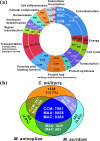

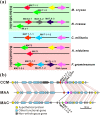
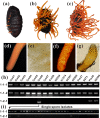
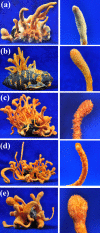
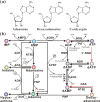


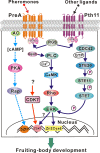
Similar articles
-
Omics data reveal the unusual asexual-fruiting nature and secondary metabolic potentials of the medicinal fungus Cordyceps cicadae.BMC Genomics. 2017 Aug 30;18(1):668. doi: 10.1186/s12864-017-4060-4. BMC Genomics. 2017. PMID: 28854898 Free PMC article.
-
Cysteine-Rich Hydrophobin Gene Family: Genome Wide Analysis, Phylogeny and Transcript Profiling in Cordyceps militaris.Int J Mol Sci. 2021 Jan 11;22(2):643. doi: 10.3390/ijms22020643. Int J Mol Sci. 2021. PMID: 33440688 Free PMC article.
-
Functional convergence and divergence of mating-type genes fulfilling in Cordyceps militaris.Fungal Genet Biol. 2016 Mar;88:35-43. doi: 10.1016/j.fgb.2016.01.013. Epub 2016 Jan 23. Fungal Genet Biol. 2016. PMID: 26812121
-
Genetics of Cordyceps and related fungi.Appl Microbiol Biotechnol. 2013 Apr;97(7):2797-804. doi: 10.1007/s00253-013-4771-7. Epub 2013 Feb 23. Appl Microbiol Biotechnol. 2013. PMID: 23435902 Review.
-
Advances in Genomics of Entomopathogenic Fungi.Adv Genet. 2016;94:67-105. doi: 10.1016/bs.adgen.2016.01.002. Epub 2016 Mar 14. Adv Genet. 2016. PMID: 27131323 Review.
Cited by
-
Study of the whole genome, methylome and transcriptome of Cordyceps militaris.Sci Rep. 2019 Jan 29;9(1):898. doi: 10.1038/s41598-018-38021-4. Sci Rep. 2019. PMID: 30696919 Free PMC article.
-
Genomic Features of Cladobotryum dendroides, Which Causes Cobweb Disease in Edible Mushrooms, and Identification of Genes Related to Pathogenicity and Mycoparasitism.Pathogens. 2020 Mar 20;9(3):232. doi: 10.3390/pathogens9030232. Pathogens. 2020. PMID: 32245129 Free PMC article.
-
Insights into Triterpene Acids in Fermented Mycelia of Edible Fungus Poria cocos by a Comparative Study.Molecules. 2019 Apr 4;24(7):1331. doi: 10.3390/molecules24071331. Molecules. 2019. PMID: 30987348 Free PMC article.
-
The Sordariomycetes: an expanding resource with Big Data for mining in evolutionary genomics and transcriptomics.Front Fungal Biol. 2023 Jun 30;4:1214537. doi: 10.3389/ffunb.2023.1214537. eCollection 2023. Front Fungal Biol. 2023. PMID: 37746130 Free PMC article. Review.
-
Comparative genome analysis of entomopathogenic fungi reveals a complex set of secreted proteins.BMC Genomics. 2014 Sep 29;15:822. doi: 10.1186/1471-2164-15-822. BMC Genomics. 2014. PMID: 25263348 Free PMC article.
References
-
- de Faria MR, Wraight SP. Mycoinsecticides and Mycoacaricides: a comprehensive list with worldwide coverage and international classification of formulation types. Biol Control. 2007;43:237–256. doi: 10.1016/j.biocontrol.2007.08.001. - DOI
-
- Zhou X, Gong Z, Su Y, Lin J, Tang K. Cordyceps fungi: natural products, pharmacological functions and developmental products. J Pharm Pharmacol. 2009;61:279–291. - PubMed
Publication types
MeSH terms
Substances
Associated data
- Actions
LinkOut - more resources
Full Text Sources
Other Literature Sources
Molecular Biology Databases
Miscellaneous

